Geof Huth's Blog, page 48
October 5, 2010
Of Voice and Eye
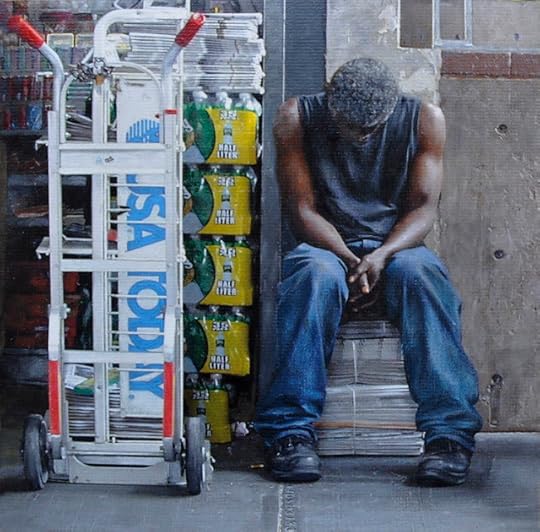
A little announcement from Didi Menendez, slightly modified by me:
The IN PURSUIT issue of POETS AND ARTISTS, featuring collaborations between artists and poets, is now online.
On the cover is a painting by Denis Peterson and reading his contributing poem for the painting "USA Today" is Geof Huth.
You may view the publication at YUDU.
POETS
Jess Burnquist
Melissa McEwen
Ron Androla
Andrei Guruianu
Grace Cavalieri
Grady Harp
William Stobb
Jim Boring
Matthew Hittinger
Howard Camner
Geof Huth
Nicole Mauro
Andrew Demcak
Walter Bjorkman
Sam Rasnake
Jamie Iredell
Denise Duhamel
Willie Perdomo
Michelle McEwen
Erika Moya
ARTISTS
William Rose
Eloy Morales
Janelle McKain
William Lazos
Karen Hollingsworth
José Parra
Glennray Tutor
Paul Belote
Kristy Gordon
Richard Frost
Denis Peterson
Alexandra Tyng
Judith Peck
Angelique Moselle Price
Brian Martin
Mary Carol
April Carter Grant
Dan LD Grant
Joshua Suda
Daniel Ochoa
ecr. l'inf.
Published on October 05, 2010 20:59
October 3, 2010
The Point at Which Letters are What They Are
I have just spent a couple of hours organizing my papers on my third floor because I need to put all of them away so a guest can sleep up there during the course of the festivities surrounding my daughter Erin's wedding this weekend. As I came downstairs, I realized I really should be working on the painting we need to do this week. There's a point at which busyness leads to poor focus, and I am there.
In point of fact, it has been a week since I gave a little performance at the Dumbo Arts Festival, and I've said not a word about that, not to mention the myriad of other events I've never reasonably reviewed. And tonight I won't do much better, but I'd like to say a few words about the work of Alan Rosner, who showed up at Central Booking to see me just before my performance but did not stay for the performance itself.
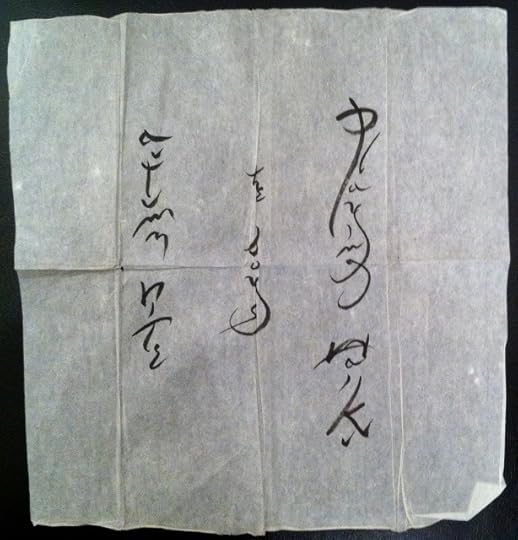 Alan Rosner, "autumn nite"
Alan Rosner, "autumn nite"
Alan actually came to meet me to meet a Huth, because his sister-in-law is a Huth, and I was impressed to hear a stranger pronounce my name correctly (rhymes with Booth, and don't add a y-sound after the H). At first I thought that was going to be the entirety of our discussion: the rarity of the name Huth, my possible but unlikely connection to his sister-in-law (my father was the last of his line until he had six children and, now, twelve grandchildren). But, just before leaving, Alan pulled two pieces of folded paper out of his wallet and opened them before me.
At first glance, these seemed to be examples of Asian calligraphy, but quickly I realized the were pieces of trompe l'oeil calligraphy: poems written in English but using outré forms for the letters. The one above reads "autumn nite / the boys / playing Haiku." These are serious pieces, but also playful, and some of the strokes of the pen here I really love, like that long leg of the p in "playing."
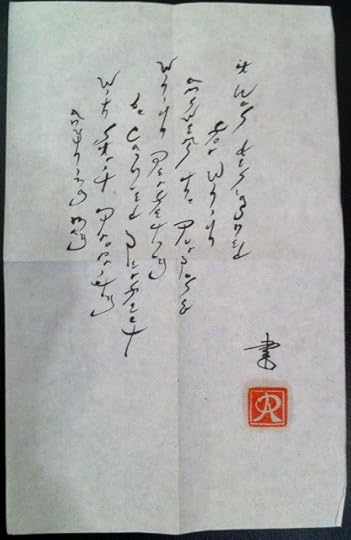 Alan Rosner, "anything may"Alan has a website called Rosner that is dedicated to the various forms of art he practices, including sculpture, and he has a section there entitled Eurasian Calligraphy that provides more examples of these works. The second example here is much longer and more complicated, but also (I'd say) a more successful job of camouflaging. Alan says these can be read in either direction (left to right or right to left), so work on this one a bit.
Alan Rosner, "anything may"Alan has a website called Rosner that is dedicated to the various forms of art he practices, including sculpture, and he has a section there entitled Eurasian Calligraphy that provides more examples of these works. The second example here is much longer and more complicated, but also (I'd say) a more successful job of camouflaging. Alan says these can be read in either direction (left to right or right to left), so work on this one a bit.
And he doesn't share my interest in the works of Xu Bing, which sometimes resemble these in affect. Alan believes Xu Bing's work is not language, thinking here of Xu Bing's asemic works. But Xu Bing also does remarkable pieces of trompe l'oeil calligraphy where characters seem to us to be real Chinese characters but then we see hidden within the complications of each character an English word.
My thanks to Alan for stopping by on a busy day under a bridge in Brooklyn.
ecr. l'inf.
In point of fact, it has been a week since I gave a little performance at the Dumbo Arts Festival, and I've said not a word about that, not to mention the myriad of other events I've never reasonably reviewed. And tonight I won't do much better, but I'd like to say a few words about the work of Alan Rosner, who showed up at Central Booking to see me just before my performance but did not stay for the performance itself.
 Alan Rosner, "autumn nite"
Alan Rosner, "autumn nite"Alan actually came to meet me to meet a Huth, because his sister-in-law is a Huth, and I was impressed to hear a stranger pronounce my name correctly (rhymes with Booth, and don't add a y-sound after the H). At first I thought that was going to be the entirety of our discussion: the rarity of the name Huth, my possible but unlikely connection to his sister-in-law (my father was the last of his line until he had six children and, now, twelve grandchildren). But, just before leaving, Alan pulled two pieces of folded paper out of his wallet and opened them before me.
At first glance, these seemed to be examples of Asian calligraphy, but quickly I realized the were pieces of trompe l'oeil calligraphy: poems written in English but using outré forms for the letters. The one above reads "autumn nite / the boys / playing Haiku." These are serious pieces, but also playful, and some of the strokes of the pen here I really love, like that long leg of the p in "playing."
 Alan Rosner, "anything may"Alan has a website called Rosner that is dedicated to the various forms of art he practices, including sculpture, and he has a section there entitled Eurasian Calligraphy that provides more examples of these works. The second example here is much longer and more complicated, but also (I'd say) a more successful job of camouflaging. Alan says these can be read in either direction (left to right or right to left), so work on this one a bit.
Alan Rosner, "anything may"Alan has a website called Rosner that is dedicated to the various forms of art he practices, including sculpture, and he has a section there entitled Eurasian Calligraphy that provides more examples of these works. The second example here is much longer and more complicated, but also (I'd say) a more successful job of camouflaging. Alan says these can be read in either direction (left to right or right to left), so work on this one a bit.And he doesn't share my interest in the works of Xu Bing, which sometimes resemble these in affect. Alan believes Xu Bing's work is not language, thinking here of Xu Bing's asemic works. But Xu Bing also does remarkable pieces of trompe l'oeil calligraphy where characters seem to us to be real Chinese characters but then we see hidden within the complications of each character an English word.
My thanks to Alan for stopping by on a busy day under a bridge in Brooklyn.
ecr. l'inf.
Published on October 03, 2010 20:57
I have just spent a couple of hours organizing my papers ...
I have just spent a couple of hours organizing my papers on my third floor because I need to put all of them away so a guest can sleep up there during the course of the festivities surrounding my daughter Erin's birthday this weekend. As I came downstairs, I realized I really should be working on the painting we need to do this week. There's a point at which busyness leads to poor focus, and I am there.
In point of fact, it has been a week since I gave a little performance at the Dumbo Arts Festival, and I've said not a word about that, not to mention the myriad of other events I've never reasonably reviewed. And tonight I won't do much better, but I'd like to say a few words about the work of Alan Rosner, who showed up at Central Booking to see me just before my performance but did not stay for the performance itself.
 Alan Rosner, "autumn nite"
Alan Rosner, "autumn nite"
Alan actually came to meet me to meet a Huth, because his sister-in-law is a Huth, and I was impressed to hear a stranger pronounce my name correctly (rhymes with Booth, and don't add a y-sound after the H). At first I thought that was going to be the entirety of our discussion: the rarity of the name Huth, my possible but unlikely connection to his sister-in-law (my father was the last of his line until he had six children and, now, twelve grandchildren). But, just before leaving, Alan pulled two pieces of folded paper out of his wallet and opened them before me.
At first glance, these seemed to be examples of Asian calligraphy, but quickly I realized the were pieces of trompe l'oeil calligraphy: poems written in English but using outré forms for the letters. The one above reads "autumn nite / the boys / playing Haiku." These are serious pieces, but also playful, and some of the strokes of the pen here I really love, like that long leg of the p in "playing."
 Alan Rosner, "anything may"Alan has a website called Rosner that is dedicated to the various forms of art he practices, including sculpture, and he has a section there entitled Eurasian Calligraphy that provides more examples of these works. The second example here is much longer and more complicated, but also (I'd say) a more successful job of camouflaging. Alan says these can be read in either direction (left to right or right to left), so work on this one a bit.
Alan Rosner, "anything may"Alan has a website called Rosner that is dedicated to the various forms of art he practices, including sculpture, and he has a section there entitled Eurasian Calligraphy that provides more examples of these works. The second example here is much longer and more complicated, but also (I'd say) a more successful job of camouflaging. Alan says these can be read in either direction (left to right or right to left), so work on this one a bit.
And he doesn't share my interest in the works of Xu Bing, which sometimes resemble these in affect. Alan believes Xu Bing's work is not language, thinking here of Xu Bing's asemic works. But Xu Bing also does remarkable pieces of trompe l'oeil calligraphy where characters seem to us to be real Chinese characters but then we see hidden within the complications of each character an English word.
My thanks to Alan for stopping by on a busy day under a bridge in Brooklyn.
ecr. l'inf.
In point of fact, it has been a week since I gave a little performance at the Dumbo Arts Festival, and I've said not a word about that, not to mention the myriad of other events I've never reasonably reviewed. And tonight I won't do much better, but I'd like to say a few words about the work of Alan Rosner, who showed up at Central Booking to see me just before my performance but did not stay for the performance itself.
 Alan Rosner, "autumn nite"
Alan Rosner, "autumn nite"Alan actually came to meet me to meet a Huth, because his sister-in-law is a Huth, and I was impressed to hear a stranger pronounce my name correctly (rhymes with Booth, and don't add a y-sound after the H). At first I thought that was going to be the entirety of our discussion: the rarity of the name Huth, my possible but unlikely connection to his sister-in-law (my father was the last of his line until he had six children and, now, twelve grandchildren). But, just before leaving, Alan pulled two pieces of folded paper out of his wallet and opened them before me.
At first glance, these seemed to be examples of Asian calligraphy, but quickly I realized the were pieces of trompe l'oeil calligraphy: poems written in English but using outré forms for the letters. The one above reads "autumn nite / the boys / playing Haiku." These are serious pieces, but also playful, and some of the strokes of the pen here I really love, like that long leg of the p in "playing."
 Alan Rosner, "anything may"Alan has a website called Rosner that is dedicated to the various forms of art he practices, including sculpture, and he has a section there entitled Eurasian Calligraphy that provides more examples of these works. The second example here is much longer and more complicated, but also (I'd say) a more successful job of camouflaging. Alan says these can be read in either direction (left to right or right to left), so work on this one a bit.
Alan Rosner, "anything may"Alan has a website called Rosner that is dedicated to the various forms of art he practices, including sculpture, and he has a section there entitled Eurasian Calligraphy that provides more examples of these works. The second example here is much longer and more complicated, but also (I'd say) a more successful job of camouflaging. Alan says these can be read in either direction (left to right or right to left), so work on this one a bit.And he doesn't share my interest in the works of Xu Bing, which sometimes resemble these in affect. Alan believes Xu Bing's work is not language, thinking here of Xu Bing's asemic works. But Xu Bing also does remarkable pieces of trompe l'oeil calligraphy where characters seem to us to be real Chinese characters but then we see hidden within the complications of each character an English word.
My thanks to Alan for stopping by on a busy day under a bridge in Brooklyn.
ecr. l'inf.
Published on October 03, 2010 20:57
October 2, 2010
A Tip o' th' Knife t' You
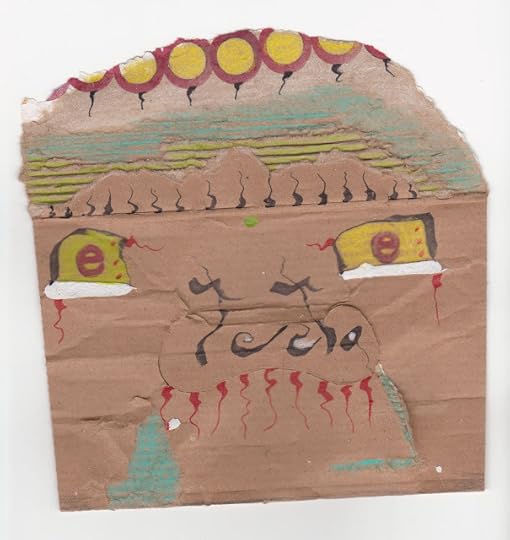 John M Bennett, "Cardboard 6 10" (2010)
John M Bennett, "Cardboard 6 10" (2010)Back in one of the golden ages of visual poetry (of which this is another), back in the late 1980s and early 1990s, Bill DiMichele (pronounced dee-mih-shell) was one third of the editorial board of Score, one of the very few magazines ever that devoted itself entirely to visual poetry. The other two thirds consisted of the husband and wife team, Crag Hill and Laurie Schneider. The magazine they put out stands as one of the hallmarks of visual poetry publishing. But that was a long time ago, and Bill disappeared from my sight for a while.
But he has returned with a new blogzine entitled Tip of the Knife, and its second issue is a simple but lovely affair. Printing a handful of visual poems by a handful of visual poets, he provides us with a good overview of the work of these poets and an issue of a magazine that it easy to ingest and digest.
With seven contributors in this issue (all male, by the way), the expanse of this is not complete, but the view of visual poetry's breadth is still quite well represented. Inside the issue are beautiful color visual poems by Guy R. Beining (who I'm used to seeing only in black and white), some comics-based poems by the indefatigable Andrew Topel, a wonderful set of iTouch-created (I'm assuming) visual poems created by Nico Vassilakis in reaction to the Avant Writing Symposium, a few visual poems by me, some wonderful cardboard-based visual poems by John M Bennett (which demonstrate, once again, how he's always working to extend beyond his past and current practice), a few slightly visual pieces by Richard Kostelanetz (which might lead me to question whether they're visual or poetry), and a few beautiful examples of textually-minimalist dirty visual poetry by Leon 5 (a name that is new to me).
Plenty though to tease the eye and the mind.
ecr. l'inf.
Published on October 02, 2010 20:59
September 29, 2010
A Poetics (54 through 59)
54. Difficulty
There are many truths we don't want to learn, and that is because there are many truths we don't want to believe. One of these is that difficulty of production does not equal value. We want hard and diligent work to produce great poems, but sometimes that is exactly what it takes to produce an execrable poem. We want a poem dashed off as if a piece of automatic writing to be without merit, but sometimes those are the poems that capture something about the magic of being human and full of words. The truth is that the manner of production only matters to the poet. The poem is a result, not a process. What ends up existing is what ends up being, and that may be good or bad.
55. Pietics
Believing in one's own narrow poetics is an empty act of rigor. Poetry is not religion. It is not a set of rules to hold you in place and sinless. It is not a chastity belt or a tourniquet. The poetics of exclusion are poetics that avoid the terrors of inspiration for the safe comfort of the rut.
56. Project
Poetry is a project. Every poet is a set of potential poems, and it is the poet's project to find those poems and to save the good ones. Some poets examine a certain set of tropes or live by a certain set of rules to produce the poetry of their projects, and they must, for all poets have to be the poets they are and make the poems they must make, seriously and joyfully. Poetry is a project, and we project ourselves and values through this project.
57. Numbering
Part of organizing a project of poems is considering how they fit together and how they are held together by the number of them there are. Numbers are always significant in a set of my poems. The number might be 365 or 366 or 52 or 50 or 25 or 101, but the number helps organize the poems, gives them additional contextual meaning, and (and this is important) tells me when to stop making them. When reviewing a chapbook of poems of mine about thirty years after it was written, I discovered it had 17 poems, and I knew immediately why. It was to increase the uncomfortable weirdness of the poems by using such an unlikely prime number. These poems were numbered, and I noticed later that there was no poem numbered 13, which was easy to explain. In a life as confused as was that of the subject of those poems, all possible extra unluckiness had to be removed. But this left the book with 16 poems, which is not at all a prime, actually an even number, and, even more strangely, a square number. So the book of uneven prime numbers became a cubic ordered structure, undermining its own apparent message.
58. Size
Size matters. Some poems are hundreds of pages long, and that length is important to make the poems mean. Some poems are no longer than a single word, and that brevity is essential to their effects. To work with size is to work with the possibilities of poetry, which are most of the possibilities we have.
59. Living
Poetry = Living. We live for the word, for the experience of the word, for the word allowed to do what the word can do. We do this even though poetry cannot be a living. We do this out of love. We poets, so obsessed with words, seem incapable of love, but we love the words we use, the words others use, the words of the air, the words of the page, the words that make it possible for us to live.
ecr. l'inf.
There are many truths we don't want to learn, and that is because there are many truths we don't want to believe. One of these is that difficulty of production does not equal value. We want hard and diligent work to produce great poems, but sometimes that is exactly what it takes to produce an execrable poem. We want a poem dashed off as if a piece of automatic writing to be without merit, but sometimes those are the poems that capture something about the magic of being human and full of words. The truth is that the manner of production only matters to the poet. The poem is a result, not a process. What ends up existing is what ends up being, and that may be good or bad.
55. Pietics
Believing in one's own narrow poetics is an empty act of rigor. Poetry is not religion. It is not a set of rules to hold you in place and sinless. It is not a chastity belt or a tourniquet. The poetics of exclusion are poetics that avoid the terrors of inspiration for the safe comfort of the rut.
56. Project
Poetry is a project. Every poet is a set of potential poems, and it is the poet's project to find those poems and to save the good ones. Some poets examine a certain set of tropes or live by a certain set of rules to produce the poetry of their projects, and they must, for all poets have to be the poets they are and make the poems they must make, seriously and joyfully. Poetry is a project, and we project ourselves and values through this project.
57. Numbering
Part of organizing a project of poems is considering how they fit together and how they are held together by the number of them there are. Numbers are always significant in a set of my poems. The number might be 365 or 366 or 52 or 50 or 25 or 101, but the number helps organize the poems, gives them additional contextual meaning, and (and this is important) tells me when to stop making them. When reviewing a chapbook of poems of mine about thirty years after it was written, I discovered it had 17 poems, and I knew immediately why. It was to increase the uncomfortable weirdness of the poems by using such an unlikely prime number. These poems were numbered, and I noticed later that there was no poem numbered 13, which was easy to explain. In a life as confused as was that of the subject of those poems, all possible extra unluckiness had to be removed. But this left the book with 16 poems, which is not at all a prime, actually an even number, and, even more strangely, a square number. So the book of uneven prime numbers became a cubic ordered structure, undermining its own apparent message.
58. Size
Size matters. Some poems are hundreds of pages long, and that length is important to make the poems mean. Some poems are no longer than a single word, and that brevity is essential to their effects. To work with size is to work with the possibilities of poetry, which are most of the possibilities we have.
59. Living
Poetry = Living. We live for the word, for the experience of the word, for the word allowed to do what the word can do. We do this even though poetry cannot be a living. We do this out of love. We poets, so obsessed with words, seem incapable of love, but we love the words we use, the words others use, the words of the air, the words of the page, the words that make it possible for us to live.
ecr. l'inf.
Published on September 29, 2010 20:59
September 28, 2010
September 25, 2010
September 24, 2010
Intermedia Poetry Reading in DUMBO (Revised)
Here's the revised schedule for the Intermedia Poetry Reading arranged by Ari Kalinowski and taking place during the DUMBO Arts Fest
Central Booking
111 Front Street
(up the stairs and to your right!)
Saturday
2:00 - 3:00 Ari Kalinowski
Introduction to Intermedia Poetry, Poemsculptures, Stained Glass Poetry
3:00 - 4:00 Jessica Elsaesser & Alaska McFadden
Poems that can only be read as they are destroyed (& other surprises)
4:00 - 5:00 Abe Nowitz
Erasures Performed on Freud's Interpretation of Dreams
5:0...
Central Booking
111 Front Street
(up the stairs and to your right!)
Saturday
2:00 - 3:00 Ari Kalinowski
Introduction to Intermedia Poetry, Poemsculptures, Stained Glass Poetry
3:00 - 4:00 Jessica Elsaesser & Alaska McFadden
Poems that can only be read as they are destroyed (& other surprises)
4:00 - 5:00 Abe Nowitz
Erasures Performed on Freud's Interpretation of Dreams
5:0...
Published on September 24, 2010 20:05
September 23, 2010
Leaf and Signal
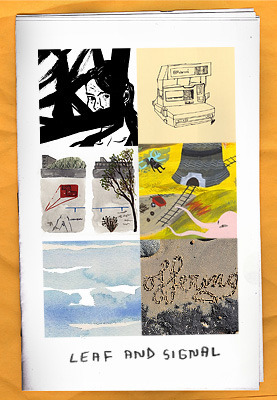
(Announcement from Warren Craghead)I'm happy to announce Leaf and Signal, a group show of international lo-fi arts publishing that I'm curating at The Bridge in Charlottesville Virginia, USA. The show will feature work and books from:
Café Royal Books (Southport, UK) with Craig Atkinson and pages from Chris Seddon, Robin Cameron, David Mackintosh, Shawn Eisenach, Neal Fox, Stephen Marshall, Peter Sutherland, Stephen Fowler, Alexander Binder, Henrik Drescher, Jack Teagle, Maxime Francourt...
Published on September 23, 2010 20:59



